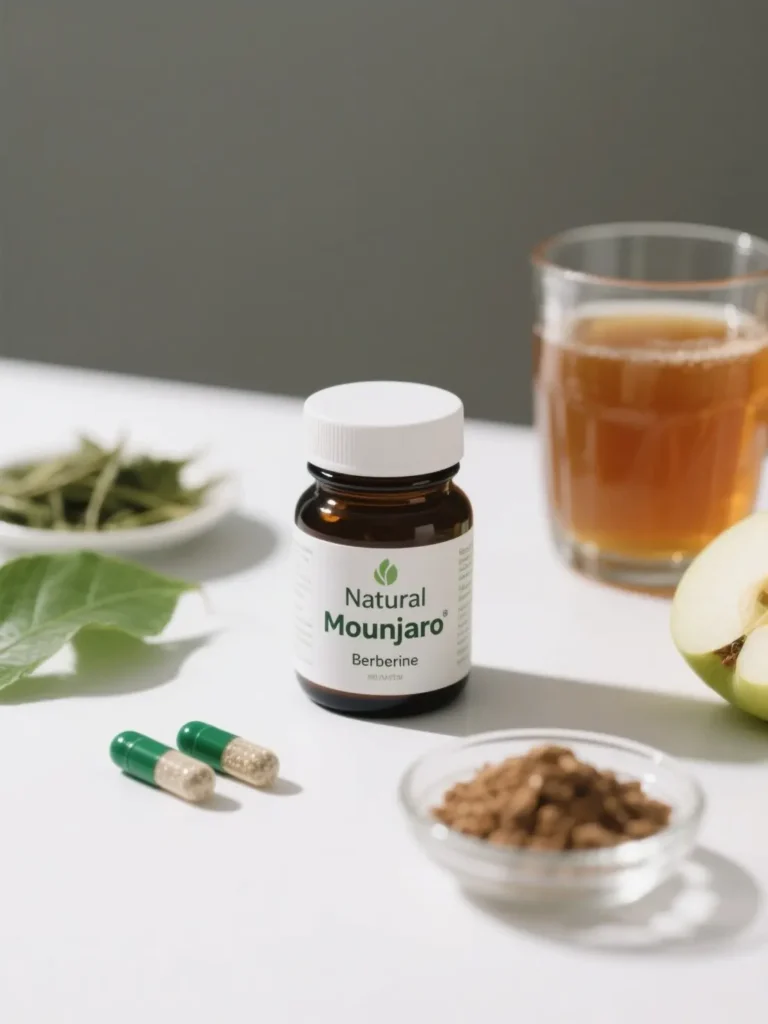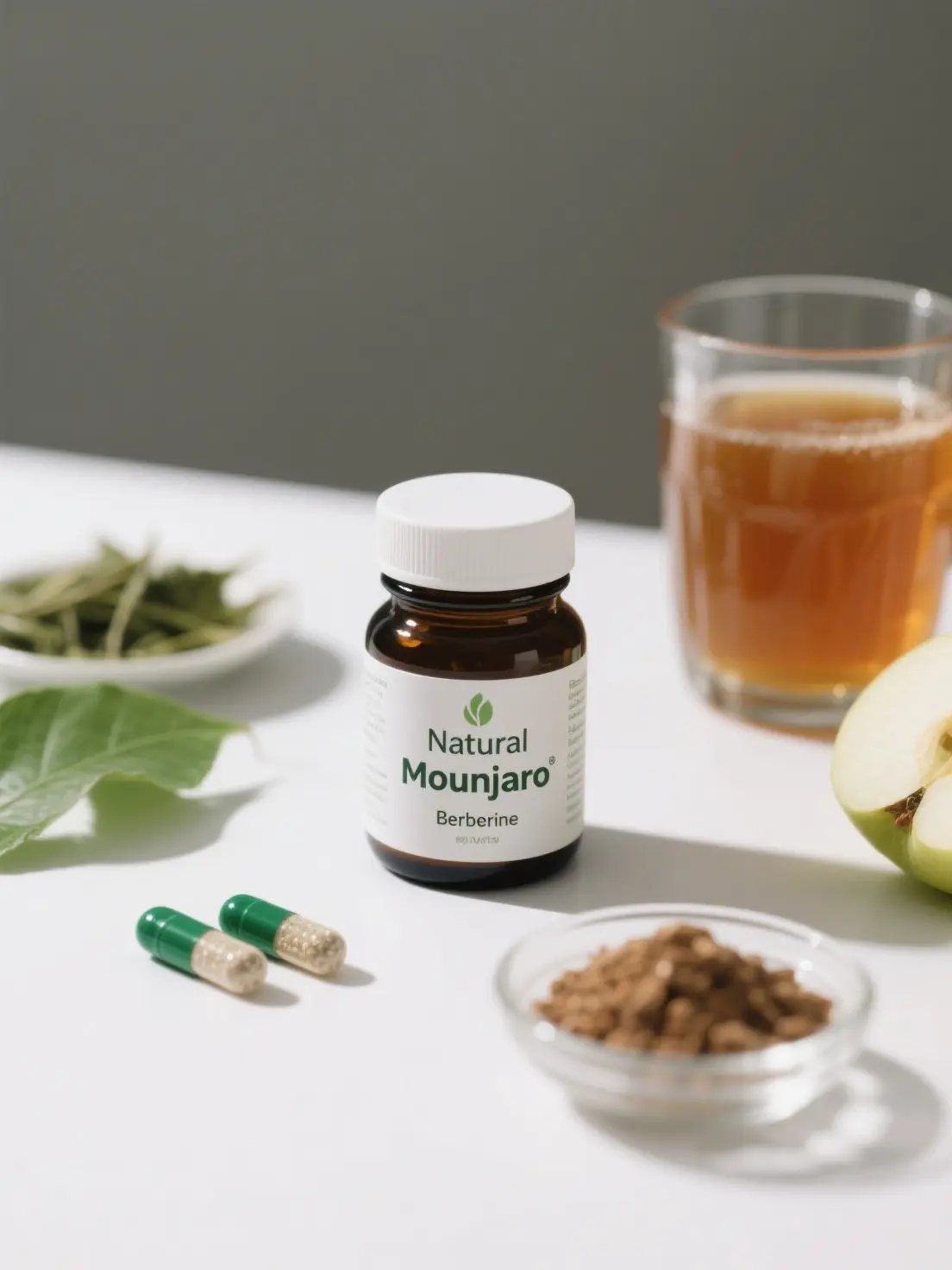Alright, let’s not beat around the protein bar “Natural Mounjaro” is trending hard. From TikTok weight loss hauls to wellness influencers dropping links in their bios, everyone seems to have an opinion. But you’re here because you’re wondering one thing: Does Natural Mounjaro really work … or is it all hype?

Honestly, I asked the same question. Because let’s face it, the real Mounjaro is prescription-only, costs a small fortune, and comes with injections. Then these “natural” versions popped up with claims like “just as effective!” or “no needle needed!” and I thought, hmm, sounds too easy.
So I rolled up my sleeves, dug through reviews, ingredient labels, and actual user stories and I’m here to break it all down for you. No marketing fluff. No wild health promises. Just facts, personal insight, and a little common sense.
Oh and if you’ve ever been burned by a too-good-to-be-true weight loss hack (lookin’ at you, cabbage soup diet), this read is 100% for you.
If you’re the kind of person who checks ingredient labels before buying anything (respect), you’ll love this breakdown of the Natural Mounjaro recipe for weight loss. It dives into what these supplements are really made of and whether the ingredients are legit or just hype wrapped in a pretty label.
Why Everyone’s Suddenly Talking About “Natural Mounjaro”
The hype isn’t random. Mounjaro (the real one) made major waves in the weight loss world by helping people lose serious pounds especially those with type 2 diabetes. But since it’s expensive, requires a doctor, and involves needles, tons of folks started searching for a natural workaround.
Enter: “natural” Mounjaro. These over-the-counter capsules or powders promise similar results, minus the prescription. They’re being sold online like hotcakes mostly labeled as herbal weight loss formulas that “mimic GLP-1,” the hormone Mounjaro affects.
But again… does natural Mounjaro really work , or is this just another supplement cash grab?
That’s what we’re here to figure out.
What We’ll Unpack in This Article (Without the Fluff)
Here’s what you can expect as we go deeper into this topic:
- What “natural” Mounjaro even is
- What it claims to do (and what it doesn’t)
- What’s actually in these pills
- Who they’re for (and who should maybe skip it)
- Tips to avoid being scammed
- Honest thoughts on whether it’s worth your money
If you’re the kind of person who likes knowing what you’re putting in your body and not just buying something because it went viral then keep reading.
Now let’s be real: natural solutions only work when used consistently and correctly. That’s what makes this pink salt trick recipe for weight loss so clever it’s quick, affordable, and easy to fold into your daily wellness routine. No overthinking required, just real ingredients doing real work (which is more than I can say for some supplements out there).
What Is Natural Mounjaro and Does It Really Work?
So here’s the first big truth bomb: Natural Mounjaro isn’t actually Mounjaro. Like, not even close.
The real Mounjaro is a prescription drug called tirzepatide, made by Eli Lilly, and it’s an injectable med originally meant to help people with type 2 diabetes. It works by mimicking hormones (GLP-1 and GIP) that regulate blood sugar and appetite.
But natural Mounjaro? It’s a nickname being used for all these new over-the-counter supplements that claim to “mimic” what the prescription stuff does. No shots. No docs. Just capsules, powders, or even drink mixes.
Natural vs. Prescription Mounjaro: What Really Works?
A lot of these natural products are leaning on the popularity of Mounjaro’s name but they don’t contain tirzepatide or anything close. That’s not always a bad thing (less risk, fewer side effects), but it also means you’re not getting the exact medical-grade results either.
They might contain plant-based ingredients that support similar functions, like blood sugar regulation or appetite control but the effects are gentler, slower, and not guaranteed.
What’s Actually Inside These “Natural” Versions
Here’s a peek at the usual suspects you’ll find on the label:
- Berberine – Used in ancient Chinese medicine, believed to help with insulin sensitivity
- Chromium – A mineral that might help regulate blood sugar
- Apple cider vinegar – Supposedly curbs appetite and balances digestion
- Green tea extract – For metabolism support
- Bitter melon – Used in Ayurvedic practices for blood sugar management
Some blends toss in fiber or cayenne pepper to “boost” metabolism. And yeah, they all make big promises sometimes too big. That’s why I always suggest reading reviews, checking sources, and not falling for wild transformation pics on shady websites.
Natural Mounjaro Claims: Does It Actually Work?
If you’re looking for a simple, natural way to support your metabolism and reduce bloating, pairing your supplement routine with a pink salt detox drink could be the move. This mineral-rich morning ritual has been trending for good reason it helps regulate digestion and set your body up for the day. And no, it’s not just TikTok hype. I tested it myself, and the difference in bloat was real.
Let’s talk about the bold claims plastered all over these bottles and ads. Most of them say things like:
- Burn belly fat fast
- Control sugar cravings
- Boost metabolism
- Shed pounds without strict dieting
- Support insulin levels
- Balance appetite
Sounds great, right? Like, who doesn’t want to lose 10 lbs while still ordering takeout?
But here’s the thing: does natural Mounjaro really work like that? Sometimes it helps, especially when paired with actual effort (think better food choices and walking a little more). But for most people, the results are subtle and slow nothing like what you’d get from the real deal.
Some folks even say it helped them kickstart their weight loss, especially if they felt stuck. Others? They felt… nothing. No side effects, no results just an expensive bottle of hope.
If you’re used to quick results like those unbelievable TikTok “3-day detoxes,” this might feel like a letdown. But hey slow, steady, and realistic? That’s usually a better route anyway.
Want to pair your supplement with something fresh and crave-worthy? Try this spicy Asian cucumber salad it’s crunchy, hydrating, and loaded with flavor without piling on calories. Honestly, it’s become a go-to reset meal in my own weight loss journey. Clean eating doesn’t have to be boring, and this recipe proves it.
Does Natural Mounjaro Really Work? Real User Experiences
So here’s the million-dollar question. Or maybe $39.99, depending on where you bought it:
Does natural Mounjaro really work , or is it just another trendy supplement with a cool label and zero follow-through?
Well… the answer’s not a simple yes or no. So let’s break it down piece by piece.
Real Users, Real Reviews (Not Just Marketing Hype)
If you’ve ever scrolled the review section on Amazon or TikTok comments, you already know: some people swear this stuff works, and others feel totally scammed.
Here’s what I kept seeing from folks who liked it:
- Lost 3–5 pounds in the first couple of weeks
- Felt “full faster” and snacked way less
- More energy (especially when they paired it with better meals)
But then others were like:
- “Did nothing for me”
- “Felt jittery and bloated”
- “Could’ve just drank water and saved $40”
Bottom line? People do report some results but it’s not a miracle pill. And if your expectations are sky-high, you’ll probably be disappointed. No judgment we’ve all fallen for magic pill promises before (I once tried a chia seed cleanse… never again).
What to Expect (If Anything) After a Week, Month, etc.
If this stuff works for you, you’ll probably notice a small dip in appetite first. Maybe you’re not crushing a whole bag of chips during Netflix. That’s a win.
But don’t expect to drop 20 pounds in two weeks. This is more of a slow shift. Most users who liked their results saw changes after about 3–4 weeks, especially when paired with walking, portion control, or simple swaps like protein snacks instead of sugar bombs.
Does Natural Mounjaro Really Work? What the Research Says
Here’s the truth: natural Mounjaro supplements haven’t been studied like prescription tirzepatide has. Most of the ingredients (like berberine or apple cider vinegar) have some research behind them individually but not enough for doctors to throw confetti.
For example:
- Berberine has shown to modestly help with blood sugar and weight control in some small studies.
- Chromium might assist with insulin resistance but the results vary like unbelievable.
- Apple cider vinegar? Kinda works for appetite, but the evidence is still mixed.
So… the science says “maybe”, not “absolutely.” Just like how some people swear by weird wellness tricks like using mayo in desserts (yep, it’s a thing) the impact really depends on your body and habits.
Speaking of smart swaps, these no-mayo deviled eggs are a total game-changer. They’re high in protein, low in carbs, and perfect for anyone trying to curb hunger without giving up flavor. If you’re trying Natural Mounjaro and want snacks that actually support your goals, add this one to your weekly meal prep.
Natural Mounjaro Ingredients Review: What Works and What Doesn’t
Let’s tear into that label like it’s a snack pack.
Here are the usual ingredients you’ll find in most natural Mounjaro-type supplements and what they might (or might not) do:
The Good:
- Berberine – Legitimate potential for blood sugar support
- Green tea extract – Natural energy boost and light metabolism support
- Chromium picolinate – May help with insulin sensitivity
- Cayenne pepper – Mild thermogenic effect (a fancy way of saying “might heat up your metabolism”)
The Meh:
- Apple cider vinegar powder – Popular, but diluted in powder form
- Garcinia cambogia – Mostly hype these days
- Raspberry ketones – No solid evidence, but still in everything
The “Wait… why?” Stuff:
- Proprietary blends – AKA “we won’t tell you how much of each thing is in here”
- Random herbal extracts with zero context
- Excess caffeine – Can cause jitters or crashes, especially if you’re sensitive
Bottom line: some ingredients make sense. Others? Not so much. Always check the label, look up each ingredient, and trust your gut (literally and figuratively).
Want to supercharge your routine while giving your digestion a gentle nudge? This pink salt weight loss recipe has been a game-changer for people pairing it with natural supplements like Mounjaro alternatives. It’s a small morning habit that supports electrolyte balance and may help flush excess water weight without needing to starve or sweat for hours.
Pros and Cons: Does Natural Mounjaro Really Work for You?
Let’s keep it simple because no supplement is all good or all bad. Here’s the breakdown, no sugar-coating.
The Perks If It Works (Spoiler: It’s All Convenience)
- No prescription required: No awkward doctor visits, no waiting room.
- No needles: If you’re squeamish, this is a big win.
- Usually cheaper: Some options cost under $50 for a month’s supply.
- Easier to get started: Pop a capsule and go.
- Might help curb cravings: A few users noticed less snacking and smaller portions.
Basically, if you’re trying to ease into better habits without going full Big Pharma, natural Mounjaro might be a decent nudge.
Risks and Letdowns (Because Nothing’s Perfect)
- Not the real thing: It won’t deliver the same clinical results as prescription Mounjaro.
- Unregulated supplements: No FDA approval = no guaranteed quality.
- Inconsistent results: What works for your best friend might do nada for you.
- Potential side effects: Some folks report bloating, headaches, or jitters.
- Can be overpriced for what you get: Especially if it’s loaded with fluff ingredients.
It’s kind of like ordering a fancy latte that sounds amazing, then realizing it’s mostly milk and syrup.
Natural Mounjaro vs Prescription Mounjaro: Real Results Compared
This part matters big time because the “real” Mounjaro is a prescription drug that went through clinical testing. Natural Mounjaro? It’s over-the-counter and more like a wellness gamble.
Prescription vs Natural: Two Different Worlds
Prescription Mounjaro:
- FDA-approved for type 2 diabetes (and being studied for weight loss)
- Contains tirzepatide a legit medication
- Works by mimicking multiple hormones that control hunger, insulin, and more
- Administered via injection (usually weekly)
- Requires doctor supervision
- Side effects are monitored
Natural Mounjaro:
- No tirzepatide
- Usually includes plant-based ingredients
- Targets weight loss indirectly via metabolism and appetite support
- Oral form (pills, powder)
- No formal regulation or testing
They’re marketed similarly, but they live in completely different leagues. It’s like comparing a home treadmill to a race car you can go places with both, but one has way more horsepower.
Price, Process, and What Your Doc Might Say
Price: Natural versions are way cheaper often $30 to $70 a month. Real Mounjaro (without insurance) can run over $1,000.
Process: Natural = online order. Prescription = doc appointment, bloodwork, insurance.
Doctor opinion: Most legit docs won’t recommend natural Mounjaro as a replacement but they might not hate it either, especially if you’re not ready for meds.
Some providers are even open to supplement stacking just be honest about what you’re taking. And please, no mixing without checking for interactions.
Who Should Use Natural Mounjaro (and Who Shouldn’t)
Not everything works for everyone. Let’s talk about who might actually benefit from this stuff and who should steer clear.
Great Fit for Some… Not So Much for Others
It might help if you:
- Need help managing cravings
- Want a mild nudge to eat less
- Are starting a new healthy routine
- Aren’t ready for prescriptions
- Prefer plant-based or “natural” options
You should probably pass if you:
- Expect massive weight loss in 10 days
- Already take meds that affect blood sugar
- Have sensitivity to caffeine or herbal extracts
- Don’t plan on changing your diet or lifestyle at all
Supplements can only do so much. It’s like putting fancy rims on a car that doesn’t run looks cool, but won’t get you far.
Should You Try It If You’re on Other Meds or Have Health Conditions?
Short answer: Ask your doctor first.
Even though it’s “natural,” some ingredients (like berberine or bitter melon) can interact with medications, especially if you’re on:
- Diabetes meds
- Blood pressure pills
- Blood thinners
One more thing: If you’ve ever dealt with thyroid issues or hormone imbalances, double-check those labels. You don’t want to mess with stuff that throws you off even more.
Natural Mounjaro Myths: Does It Really Work or Not?
The internet is wild, and when it comes to weight loss stuff, it gets even messier. So let’s bust a few myths that keep popping up around this “natural Mounjaro” trend.
“It’s the Same as the Real Thing” Nope.
This one’s everywhere. But no—natural Mounjaro is not the same as the prescription version. Not in ingredients, strength, results, or anything else.
The only thing they share is the name (and even that’s kinda sketchy). Don’t let packaging fool you. Just because something sounds science-y doesn’t mean it came from a lab.
“It Works Overnight” Not Even Close
If someone says they dropped 12 pounds in three days from a capsule? Either:
- They’re lying
- They’re leaving out the part where they also didn’t eat and ran five miles a day
Weight loss that sticks around takes time. If natural Mounjaro works, it’ll be a slow, steady thing, not a dramatic drop. It’s not Ozempic in a bottle. It’s more like a gentle nudge in the right direction.
“It Has No Side Effects Because It’s Natural”
Sorry, but nope. “Natural” doesn’t mean “harmless.”
People can still have side effects like:
- Headaches
- Upset stomach
- Dizziness
- Jitters (especially if there’s hidden caffeine)
Always read labels and listen to your body. And if something feels off? Stop taking it. No brownie points for pushing through.
Buying Natural Mounjaro? What to Know Before You Try
So you’ve read this far and maybe you’re thinking, “Okay, I might try it.” Cool. But don’t just click the first ad you see a lot of those sites are shady AF.
Here’s how to shop smart.
Look for These Signs of a Legit Supplement
- Transparent labels: You should know exactly what’s in every capsule
- Clear ingredient list: No “proprietary blends” that hide dosages
- Real reviews: Not just fake 5-stars with identical language
- Return policy: If it doesn’t work, can you get your money back?
Look for third-party testing or clean certifications if you can find them. It’s a good sign the company’s doing things the right way.
Red Flags That Should Make You Click Away Fast
- “Shark Tank approved!” (It’s not ever.)
- “Limited-time trial, just pay shipping” (You’re signing up for auto-billing, guaranteed.)
- “Doctors hate it!” (Please.)
- No ingredients or dosage info
- Sketchy URLs or typos all over the site
If it looks shady, trust your gut and bounce. Spend that money on something actually worth it like ingredients for this unbelievable-good banana waffles recipe that won’t leave you wondering if your credit card’s been cloned.
Natural Mounjaro: What to Expect If You Give It a Shot
So let’s say you grab a bottle and give it a go. Here’s what the ride might look like.
Timeline, Side Effects, and What Real People Say
- Week 1–2: Maybe you feel less hungry. Maybe nothing happens. Most folks don’t notice anything major right away.
- Week 3–4: Some people start to see small changes in weight or cravings. Others just feel more “in control” of snacking.
- After a month: Results (or lack of them) tend to be clear by now. If you’re not seeing anything at this point, it might not be your match.
Side effects are usually mild but can happen. Start with a half-dose if you’re unsure, and don’t mix it with other stuff unless your doctor gives you the green light.
How to Track Your Progress Without Obsessing
Skip the scale drama. Instead, track:
- How your clothes fit
- Your energy levels
- Your cravings
- Mood or sleep changes
Take progress pics if that’s your thing. Just don’t get too caught up in numbers this isn’t a crash diet, and results aren’t supposed to be instant.
Boost Results: What to Pair With Natural Mounjaro
Natural Mounjaro on its own? Maybe it helps, maybe it doesn’t. But when you combine it with a few smart changes, your chances of seeing results go way up.

Food Tips to Help Natural Mounjaro Work Better
You don’t need a fancy diet to get things moving just a few swaps can change the game:
- White bread → Whole grain toast or sprouted bread
- Sugary drinks → Flavored sparkling water or herbal tea
- Big dinner plates → Smaller bowls = automatic portion control
- Candy stash → Greek yogurt + fruit or dark chocolate chips
Also, eat more protein at breakfast—it keeps you fuller longer. Try eggs, yogurt, or even cottage cheese (yeah, it’s making a comeback).
Easy Exercise Habits That Support Natural Mounjaro
Let’s be real: not everyone’s hitting the gym at 6 AM. But movement matters—and it doesn’t have to suck.
Try this:
- 10-minute walk after lunch or dinner
- Bodyweight squats while watching TV
- Dance breaks (no one has to see you)
- Stretching before bed for better sleep and recovery
Consistency > intensity. A little every day beats one huge workout followed by a week on the couch.
Better Than Natural Mounjaro? Try These Alternatives
If you’re not vibing with the results (or the idea) of Natural Mounjaro, don’t sweat it there are other options.
GLP-1 Alternatives: Natural Boosters That Might Work
Some foods and supplements might lightly support GLP-1 production, which helps with appetite control:
- Berberine – One of the most studied natural alternatives
- Whey protein – May increase GLP-1 after meals
- Probiotics – Gut health can influence hormones like GLP-1
- Fermented foods like kefir or kimchi
Again, these aren’t magic—but stacking smart things together can make a difference.
Appetite Control Alternatives to Natural Mounjaro
- Green tea extract – Some metabolism support
- Glucomannan – A fiber that expands in your stomach and helps you feel full
- Yerba mate – May reduce appetite slightly
- Peppermint tea – Calming and might curb cravings
Just don’t overload on these. Too many herbs at once = bloated and grumpy. Ask your doc if you’re unsure.

Does Natural Mounjaro Really Work? The Truth Behind The Hype
Ingredients
Method
- Mix green tea, ginger, and cinnamon in hot water. Let steep for 5–7 minutes.
- Strain and stir in apple cider vinegar and lemon juice.
- Add honey or stevia if desired. Serve warm or chilled.
- Consume once daily in the morning on an empty stomach.
Nutrition
Notes
Tried this recipe?
Let us know how it was!Final Verdict: Does Natural Mounjaro Really Work or Not?
So… we’ve looked at the claims, the ingredients, the science (and the lack of it), and the real-life feedback.
Natural Mounjaro Review Summary: Worth It or Skip It?
If you’re expecting a prescription-level fat burner in pill form?
Skip it. You’ll be disappointed.
If you want a light boost, are open to subtle changes, and plan to also tweak your diet and activity?
Might be worth trying.
Just go in with the right expectations and if you try it, commit to at least a few weeks and track how you feel. No supplement can carry the whole load on its own.
FAQs: Answers to Your Does Natural Mounjaro Really Work ? Questions
What is the difference between real and natural Mounjaro?
The real Mounjaro is a prescription drug with clinical testing and FDA approval. Natural Mounjaro is an over-the-counter supplement that mimics some of the effects but doesn’t contain the same active ingredient (tirzepatide).
Can I lose weight with just the natural supplement?
Maybe. Some people report moderate weight loss, but it’s usually slow and small. Best results come when it’s combined with better food choices and regular movement.
Are there side effects with natural Mounjaro?
Yes, some users experience bloating, headaches, jitteriness, or digestive issues. Always read the label and start slow to see how your body reacts.
Do I need a prescription?
Nope. That’s the big appeal of natural Mounjaro—anyone can buy it online or in stores without a prescription.
Is it safe to use long-term?
That depends on the ingredients and your health. Because supplements aren’t regulated like meds, long-term safety isn’t always clear. Talk to a healthcare provider if you’re unsure.
Can I use it with other weight loss programs?
In many cases, yes—but check for ingredient conflicts. If you’re using a structured program like Noom, WW, or Ozempic, ask your doctor first to avoid overlap or side effects.
